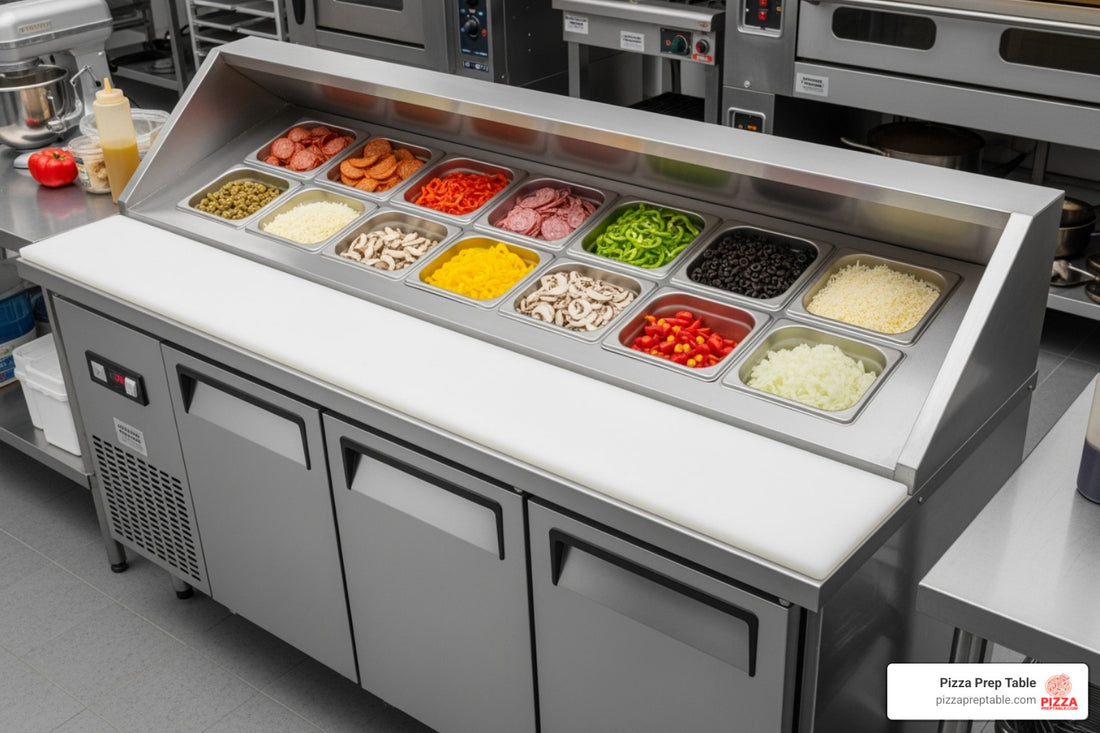
Under the Counter, Over the Top: Pizza Bench Fridges Reviewed
Share
What is a Pizza Bench Fridge and Why Does Your Pizzeria Need One?
A pizza bench fridge is an essential piece of equipment that combines refrigerated storage with a dedicated prep workspace. These units maintain an ideal temperature range of 33 b0F-41 b0F (1 b0C-5 b0C), keeping your most-used ingredients perfectly chilled and within arm's reach during assembly. Unlike a standard refrigerator or a simple prep table, a pizza bench fridge merges cold storage with an efficient work surface, eliminating the constant back-and-forth that slows down a busy kitchen.
The efficiency gains are immediate. With everything at your fingertips, your team can assemble pizzas faster, ensuring dough stays fresh, cheese maintains its texture, and vegetables keep their crispness. For pizzerias with limited space, these units are a smart investment, maximizing productivity while ensuring food safety compliance. The right pizza bench fridge isn't just equipmentit's the foundation of a smooth and profitable operation.
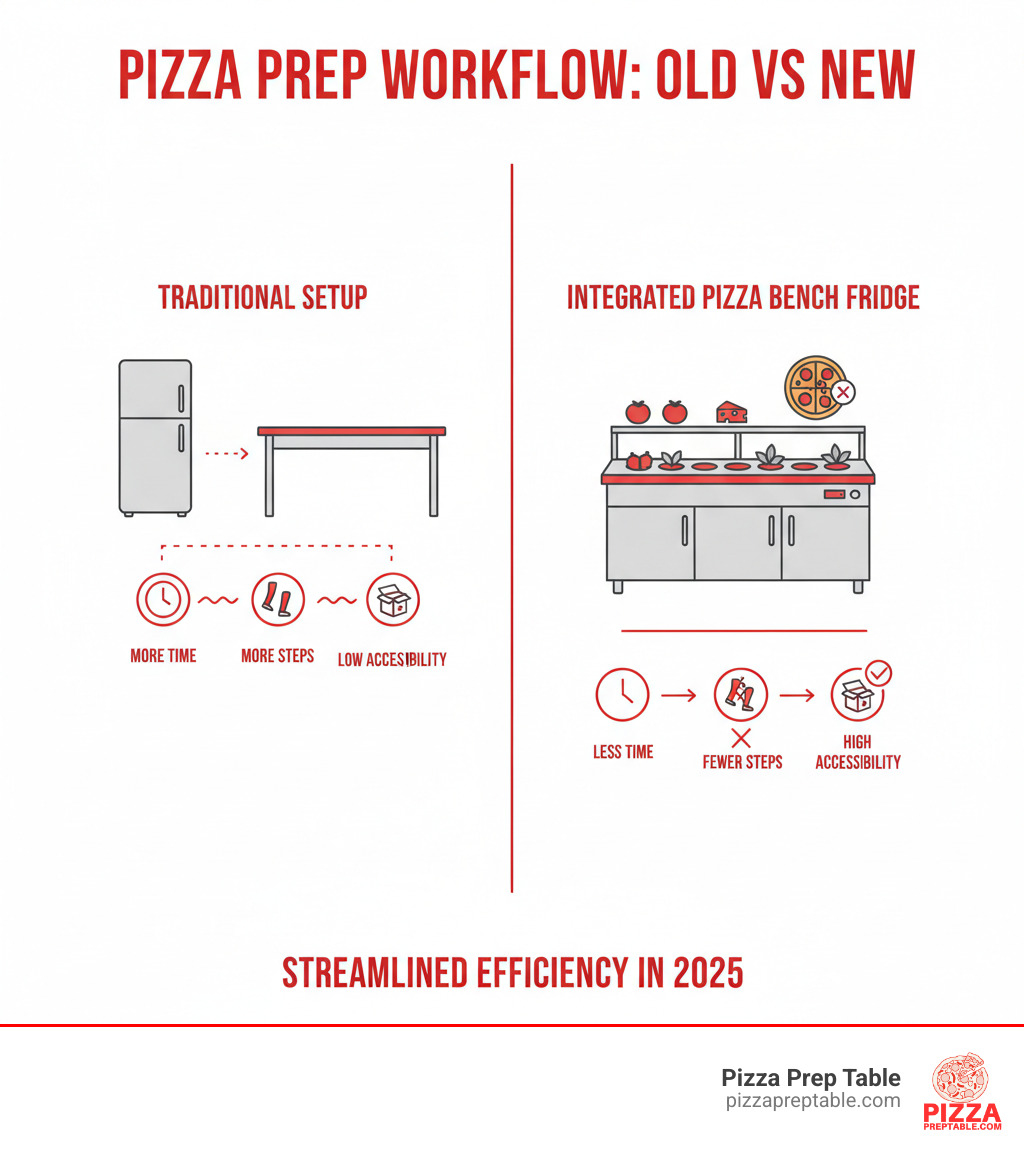
By consolidating tasks, a pizza bench fridge revolutionizes kitchen workflow. Without one, staff must retrieve ingredients from a separate cooler, walk to a prep table, and then assemble the pizza. This fragmented process creates delays and increases food safety risks as ingredients are exposed to warmer temperatures. With a pizza bench fridge, the entire process occurs in one seamless motion. Refrigerated wells hold GN pans with toppings, while the integrated work surface provides a dedicated area for dough prep. This streamlined approach reduces movement, cuts prep time, and keeps ingredients at safe temperatures, directly contributing to quality and customer satisfaction. You can learn more in our guide on Doughn't Settle for Less: Choosing the Perfect Pizza Preparation Refrigerator.
Essential Features to Look For
When selecting a pizza bench fridge, prioritize these features for optimal performance:
- Digital Temperature Controls: Allow for precise temperature monitoring to keep ingredients between 33 0b0F and 41 0b0F (1 0b0C and 5 0b0C), ensuring freshness and safety.
- Self-Closing Doors: A crucial energy-saving feature that automatically seals the refrigerated cabinet, maintaining consistent temperatures in a busy kitchen.
- GN Pan Compatibility: The unit must accommodate standard Gastronorm (GN) pans (e.g., 1/3, 1/4 sizes) for organizing toppings in the top rail.
- Raised Pan Rail with Insulated Lid: Provides ergonomic access to ingredients while the insulated lid protects them from ambient heat and contaminants.
- Casters for Mobility: Heavy-duty casters, often with brakes, allow you to easily move the unit for cleaning, maintenance, or kitchen reorganization.
- Durable Worktop: A robust work surface is essential. A deep polyethylene cutting board provides ample prep space, while a granite top can prevent dough from sticking.
For more insights on materials, read our article Slice in Style: Choosing a Stainless Steel Pizza Prep Table.
Construction and Hygiene: Built to Last
The durability and sanitation of your pizza bench fridge depend on its construction.
- Stainless Steel Construction: The industry standard for commercial equipment, stainless steel interiors and exteriors offer excellent resistance to corrosion and are easy to clean and sanitize.
- Worktop Materials: Granite or marble worktops provide a naturally cool surface ideal for working with dough. Polyethylene cutting boards are a common alternative, offering a food-safe, non-porous, and knife-friendly prep area.
- Hygienic Design: Look for features like removable magnetic door gaskets, which are easy to clean or replace, and NSF or ETL certifications. These certifications ensure the equipment meets strict public health and safety standards, a vital assurance for any commercial kitchen.
Robust construction ensures your unit can withstand the demands of a busy kitchen while maintaining the highest hygiene standards. For more details, you can refer to resources like the NSF food equipment standards.
Cooling, Temperature, and Energy Efficiency
Understanding the refrigeration system is key to performance and cost management.
- Ideal Temperature Range (33 0b0F-41 0b0F / 1 0b0C-5 0b0C): This range is critical for inhibiting bacterial growth in perishable ingredients like cheese, meat, and sauces.
- Cooling Systems: Most commercial units use fan-assisted (dynamic) cooling to circulate cold air, ensuring uniform temperatures and faster recovery after door openingsessential for busy kitchens.
- Refrigerants: Modern units often use eco-friendly hydrocarbon refrigerants like R290 or R600A, which have a low environmental impact and are highly efficient.
- Energy Efficiency: Look for features that lower operational costs, such as high-density CFC-free insulation, self-closing doors, and a design rated for your kitchen's ambient temperature. These elements reduce the compressor's workload, saving energy and extending the unit's lifespan.
Top Pizza Bench Fridges on the Market: A 2025 Review
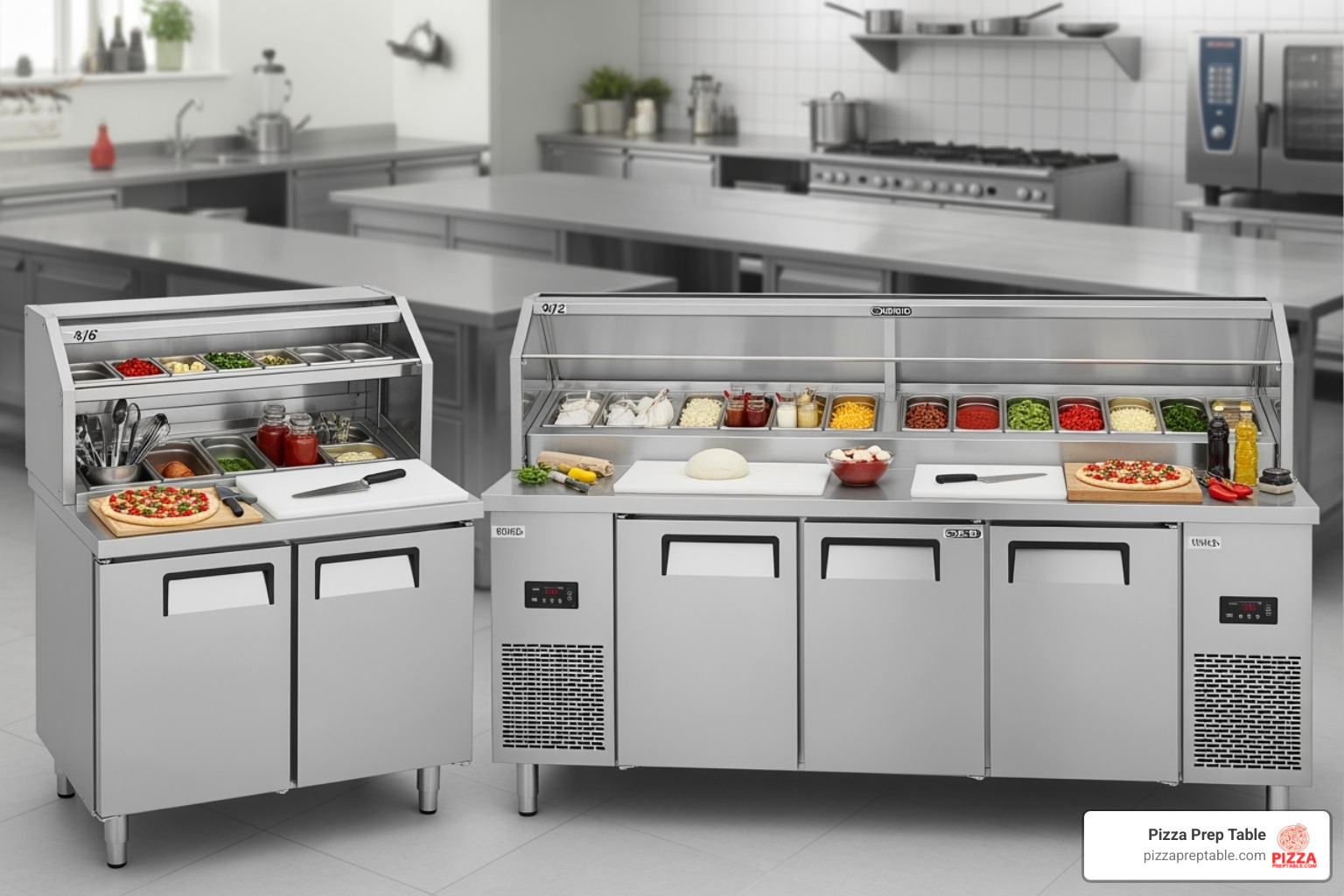
Choosing the right pizza bench fridge depends on your pizzeria's specific needs. Most successful setups fall into three main categories, from compact units for smaller shops to high-capacity models for busy restaurants. The market offers a solution for every type of operation, whether you're just starting out or cranking out hundreds of pies a shift. Let's explore which type might be your kitchen's new best friend.
The Compact Powerhouse: 2-Door Pizza Bench Fridge
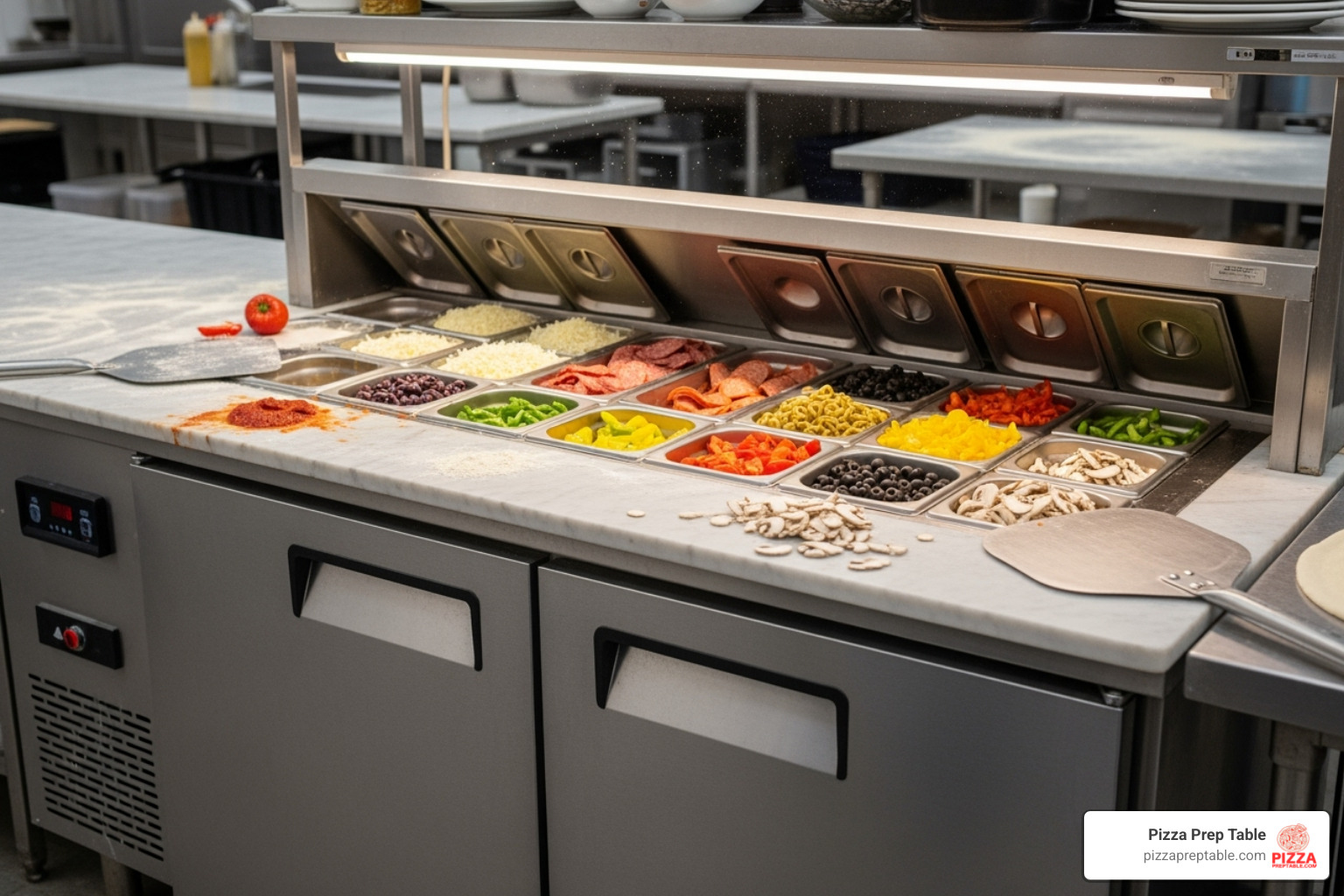
Ideal for cozy pizzerias, food trucks, or kitchens with limited space, these 2-door units pack serious functionality into a space-saving design. They offer a sweet spot of storage and prep area without the bulk of larger models.
Typically ranging from 44 to 67 inches in width with capacities of 250-400 liters, they provide ample room for daily ingredients. Models like the Frigos FG-PZPT-67 offer 20.8 cubic feet of storage, while others like the FED-X XSS7C13S2V can hold 7 x 1/3 GN pans, maximizing topping variety in a small footprint. These units prove you don't need a massive station to maintain an efficient workflow.
For detailed comparisons, check out our guide Slice and Dice with Ease: 2-Door Pizza Prep Fridges Reviewed. If a mid-sized option is what you need, our 60-Inch Pizza Prep Table guide can help.
The High-Volume Hero: 3-Door Pizza Bench Fridge
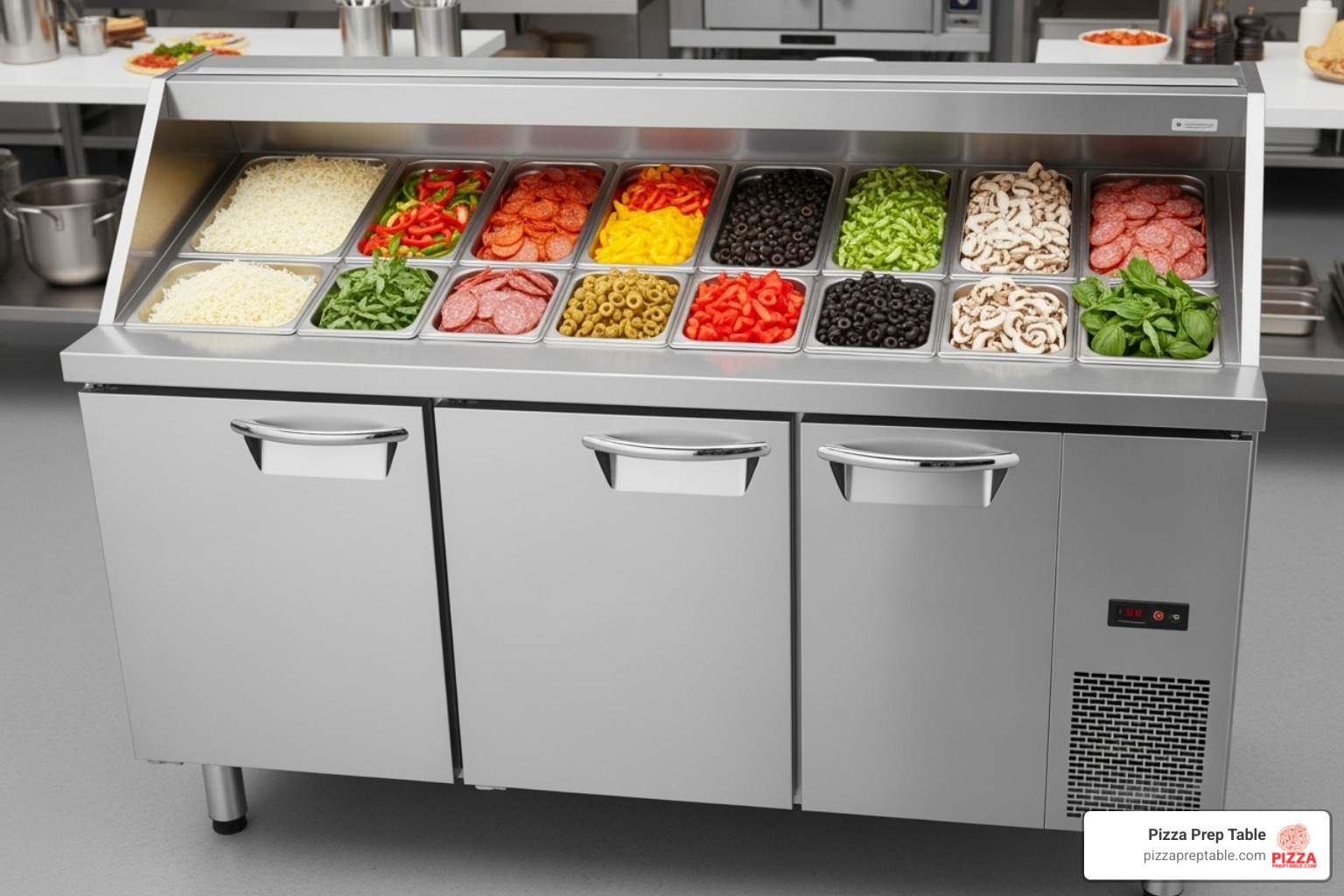
When your pizzeria is constantly in motion, you need a pizza bench fridge that can keep up. These 3-door giants are built for restaurants that measure success in hundreds of pizzas per day.
With storage capacities often starting around 500 liters and widths exceeding 90 inches—like the Maxx Cold 3 Door model—you get a legitimate production line. This expanded workspace allows multiple staff members to work simultaneously without issue. These units also handle extensive topping selections with ease, with some accommodating 12 or more 1/3 GN pans. They are designed to perform during your busiest shifts when running out of ingredients is not an option.
Explore options like the Atosa Pizza Prep Table 93 or browse our complete 93-inch pizza prep table collection to see what peak performance looks like.
The Organizer's Dream: Prep Fridges with Drawers
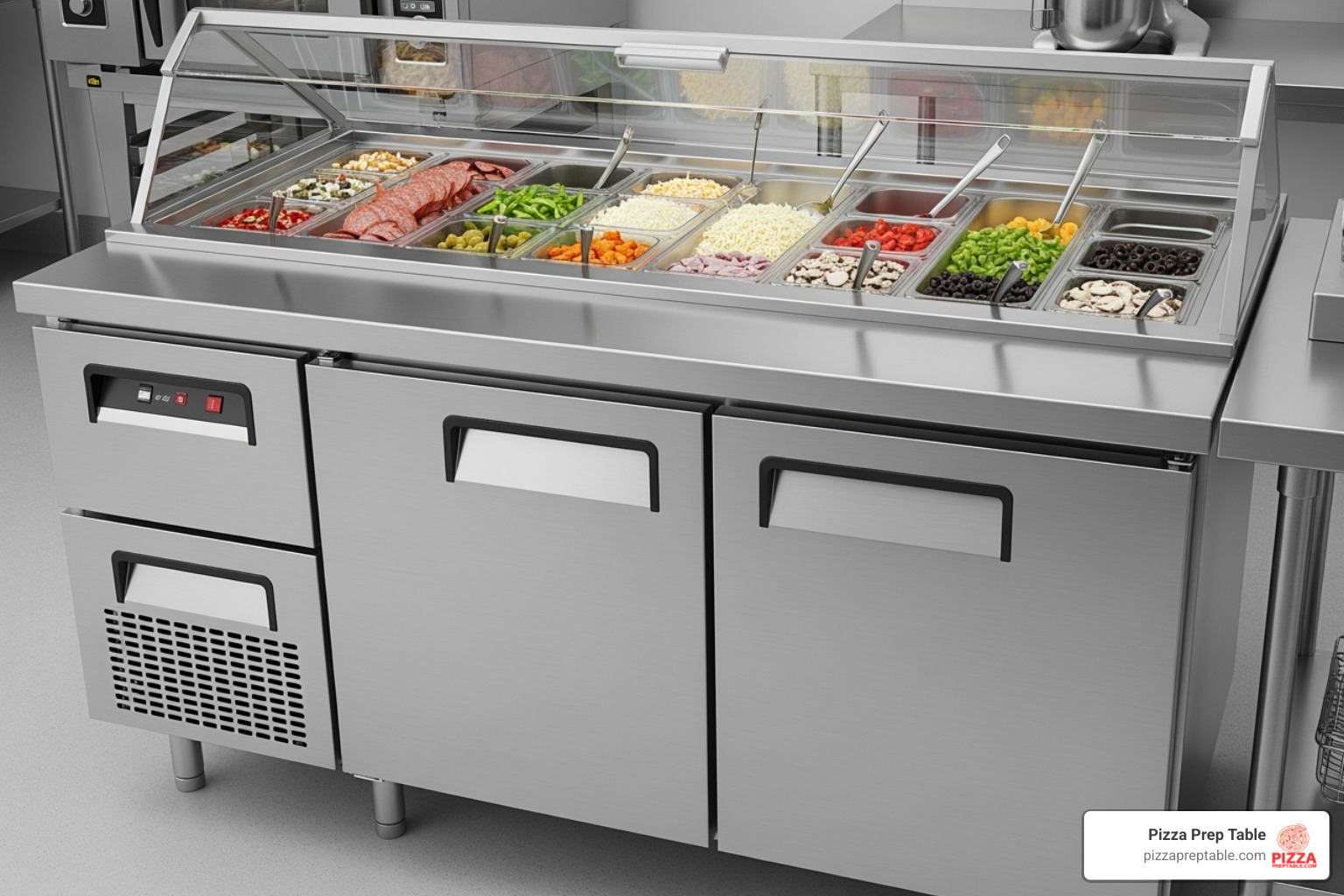
For pizzeria owners who value organization, adding drawers to a pizza bench fridge is a game-changer. Drawers provide effortless, ergonomic access to perfectly organized dough trays, eliminating the hassle of storing them on shelves.
Beyond dough, drawers create natural compartments for pre-portioned meats, specialty cheeses, and fresh herbs. This separation prevents flavor contamination and makes inventory management more intuitive. The pull-out design also reduces the physical strain of bending and reaching, which adds up to less fatigue and better performance during long shifts. Models with a mix of doors and drawers, like the Beverage-Air DPD93HC-6T, offer the best of both worlds: organized storage for frequently accessed items and bulk storage behind doors.
For more specialized solutions, explore our Dukers Pizza Prep Table collection, which features various configurations for the organized kitchen.
How to Choose the Right Pizza Bench Fridge for Your Kitchen
Choosing the perfect pizza bench fridge becomes clear when you focus on your operation's specific needs. The right choice balances space, budget, and workflow.
Your kitchen space is the first constraint. Measure your area carefully, accounting for door swing and ventilation space, before falling in love with a unit that won't fit. Your budget should be viewed as a long-term investment; the cheapest option rarely saves money if it leads to costly repairs and downtime.
Your daily order volume and menu complexity are the best indicators of what you need. A low-volume cafe can thrive with a compact 2-door unit, while a restaurant making hundreds of pizzas a day will need the capacity of a 3-door model to keep up. Similarly, a complex menu with many toppings requires more GN pan slots to stay organized.
Here's how the most popular configurations stack up:
| Model Type | Typical Width Range | Capacity Range (Liters / Cu. Ft.) | GN Pan Count (Top) | Price Range (Approx.) | Best For |
|---|---|---|---|---|---|
| 1-Door | 44-50 inches | 250-300L / 10-12 Cu. Ft. | 4-6 x 1/3GN or 1/4GN | $800 - $2,000 | Small cafes, food trucks |
| 2-Door | 60-72 inches | 400-550L / 15-20 Cu. Ft. | 6-8 x 1/3GN or 1/4GN | $2,000 - $4,000 | Medium-volume pizzerias |
| 3-Door | 90-94 inches | 550L+ / 20-30+ Cu. Ft. | 9-12 x 1/3GN or 1/4GN | $4,000 - $15,000+ | High-volume restaurants |
Sizing and Capacity: Finding the Perfect Fit
Getting the size right is about matching the unit's capacity to your workflow. Width (from 44 to 94+ inches) dictates how many staff can work at once. Depth and height are fairly standard, but a deeper cutting board (e.g., 18 inches) provides crucial workspace for larger pizzas. Match the internal volume (from 240L to over 2000L) to your inventory turnover to avoid wasting energy on unused space. Finally, ensure the GN pan capacity in the top rail fits your menu's topping variety.
For specific sizing guidance, our article on The Perfect Fit: Choosing a 48-Inch Pizza Prep Table walks through the decision process in detail.
Understanding Cost vs. Value
The price of a commercial pizza bench fridge can be surprising, but value extends beyond the initial cost. While size is a major price driver, features like full stainless steel construction, granite worktops, and digital controls add durability and efficiency that pay off over time.
Brand reputation and a solid warranty (e.g., 3 years parts and labor) are worth paying for, as they protect you from costly downtime and repairs. Energy efficiency, driven by modern refrigerants like R290 and good insulation, can save hundreds on utility bills over the unit's lifespan. Also, consider financing options like "Rent-Try-Buy" programs, which can help you acquire quality equipment without a massive upfront capital expense.
A cheap unit that breaks down will cost more in the long run. For budget-conscious buyers, exploring quality used equipment can be a smart move, as covered in Used But Not Abused: Finding Quality Pizza Prep Tables on a Budget.
Keeping Your Cool: Maintenance and Care for Your Pizza Bench Fridge
Regular maintenance is crucial for protecting your investment in a pizza bench fridge and ensuring it runs efficiently for years to come. Consistent care prevents costly breakdowns and guarantees your ingredients stay fresh.
Daily Cleaning:
- At the end of each shift, wipe down all stainless steel surfaces, cutting boards, and ingredient rails with a food-safe cleaner and a damp cloth.
- Thoroughly wash all Gastronorm pans and their lids.
- Immediately clean any spills inside the refrigerated compartments to prevent odors and bacteria buildup.
Weekly Maintenance:
- Clean the Condenser Coils: These coils dissipate heat and can get clogged with dust and grease. Use a stiff brush and vacuum to clean them. This is the most important task for maintaining energy efficiency and preventing compressor failure.
- Inspect and Clean Door Gaskets: Wipe the rubber seals with warm, soapy water and check for any tears or damage. A tight seal is essential for keeping cold air in.
- Check the Condensate Drain: Ensure the drain line is clear and flowing freely to prevent water damage and mold growth.
Periodic and Professional Care:
- Monthly, check that the unit is level and visually inspect electrical connections for wear.
- Schedule a professional service visit at least once a year. A qualified technician can check refrigerant levels, inspect the compressor, and catch potential issues before they become emergencies.
A well-maintained pizza bench fridge runs more efficiently, lasts longer, and delivers the consistent quality your customers expect. For general best practices on commercial refrigeration efficiency, review ENERGY STAR guidance.
Frequently Asked Questions about Pizza Prep Fridges
Here are answers to the most common questions we hear from pizzeria owners about choosing and using a pizza bench fridge.
How is a pizza bench fridge different from a standard prep table or refrigerator?
A pizza bench fridge is an all-in-one workstation designed specifically for making pizzas. Unlike a standard setup with separate units, it integrates three key components:
- Refrigerated Ingredient Wells: Keeps toppings chilled and accessible at the prep line.
- A Deep Work Surface: Often an 18-inch cutting board, providing ample space for stretching dough and assembling large pizzas.
- Under-Counter Storage: Configured to hold dough boxes and other bulk ingredients.
This integrated design creates a seamless workflow, eliminating wasted steps and boosting kitchen efficiency. For a broader look at kitchen tables, see our guide on Table Talk: Restaurant Kitchen Prep Tables Explained.
What is the ideal temperature for storing pizza ingredients?
The ideal temperature range for a pizza bench fridge is between 33°F and 41°F (1°C and 5°C). This is crucial for two reasons:
- Food Safety: It keeps perishable ingredients like meats and cheeses out of the temperature "danger zone" (41°F to 135°F), where bacteria multiply rapidly.
- Ingredient Quality: This range preserves the crispness of vegetables, maintains the texture of cheese, and allows for the controlled, slow proofing of dough stored in the under-counter section.
Can I use a sandwich prep table for pizza?
While technically possible in a pinch, using a sandwich prep table for pizza is highly inefficient and not recommended. The designs are fundamentally different:
- Cutting Board Depth: Sandwich units have shallow boards (around 10-12 inches), which are too narrow for stretching and assembling pizzas. Pizza prep tables feature deep boards (18+ inches).
- Pan Rail Configuration: Pizza tables are designed to hold more or larger GN pans to accommodate a wide variety of toppings.
- Under-Counter Storage: The storage in a pizza prep fridge is often configured for bulky dough boxes, which won't fit in a standard sandwich unit.
Using the right tool for the job—a proper pizza bench fridge—will save you time and frustration. Learn more about the differences in our article on the Sandwich Prep Table.
Conclusion: The Ultimate Investment for Your Pizzeria
Choosing the right pizza bench fridge is one of the most impactful decisions you can make for your business. It is the heart of your production line, directly influencing your kitchen's efficiency, food safety, and consistency.
Every pizza you serve starts at this station. A dedicated unit with digital temperature controls, self-closing doors, and durable stainless steel construction ensures your ingredients are perfect and your workflow is seamless. Whether you need a compact 2-door model or a high-volume 3-door powerhouse, the right fridge pays for itself in reduced labor costs and improved product quality.
This investment is your competitive advantage. When the orders pile up, you'll be glad you chose equipment designed for the job. Ready to find the perfect fit? Explore our complete collection of commercial pizza prep tables to transform your operations and ensure long-term success.
